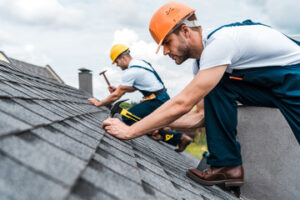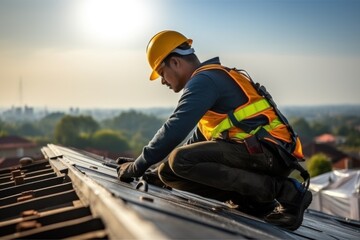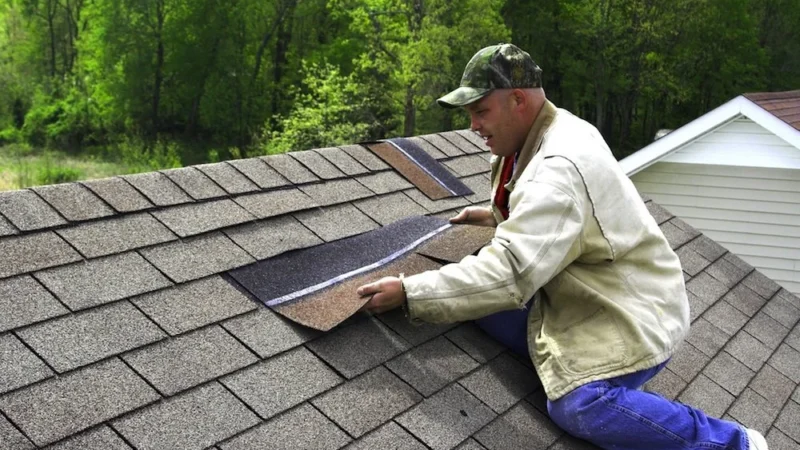Factors That Affect the Time and Cost of Roof Repair
Roof repair fixes components such as shingles, tiles, ridge vents ventilation, and more leaking or damaged. It takes less time than a complete replacement and costs much less.

Start by sweeping debris off the roof and drying it with a challenging broom. Look for stains, drips, mold and mildew, rust spots, and granules in the gutter (old shingles shed these as they age). Visit https://www.fresnoroofingexperts.com/ to learn more.
The weather plays a huge role in roof repair. It’s important for roofing professionals to understand what kind of damage different types of weather can cause and what effect it can have on the repair process. This can help them plan projects more effectively and give clients a better understanding of what they need to do in order to protect their homes.
Severe storms can wreak havoc on rooftops, causing everything from shingle deterioration to major structural damage. In some cases, roofs may be so damaged that they need to be replaced entirely. In these situations, a roofing professional can work with the property owner and insurance company to ensure that the claim is processed correctly and efficiently.
Rain, snow, and humidity are all significant factors to consider when addressing roof repairs. Moisture can seep into cracks and erode materials, requiring extra care when working on the roof. High winds can also make it unsafe to be on the roof and can potentially damage materials, compromising the integrity of the repair. It’s essential to choose a season with stable weather patterns for roofing projects.
Hail damage is another common issue that can impact roofs. It can create hairline cracks, weaken shingles, and dislodge granules, all of which can be difficult to identify and address. Additionally, hail can cause dents in metal flashings and eaves.
In most cases, repairing hail damage is possible. The first step is to inspect the roof to assess the extent of the damage. Look for signs of water leaks, dripping water, stains, and pooled water. Then, locate the source of the leak. This might require removing a section of the roof to expose the leaky area. Once the source of the leak is identified, a roofer can replace the damaged flashing and reseal the areas where necessary.
Materials
When it comes to repairing your roof, the right materials are critical. Not only do the materials need to be compatible with your existing roof, but they should also be weather-resistant and durable enough to protect your home for years.
Some of the most essential roof repair materials include shingles, roofing cement, and flashing. These materials help to repair cracks, leaks, and damaged shingles or tiles. They also help to create a waterproof seal around any roof penetrations like chimneys, skylights, or vents.
Another important material for roof repairs is fabric and tape. Tape can be used to patch small holes in the roof, while fabric is often used to reinforce weak spots on shingles or roof tiles. This can help to keep water from seeping through the roof and damaging your home.
Having the right tools is also important for roof repair. A hammer and nail gun are both useful for securing shingles, roofing tiles, and metal sheets to the roof. It is important to use a hammer that is heavy enough for the job and a nail gun that has adjustable settings to ensure you get the nails in at the proper depth.
A ladder and safety harness are also essential for working on the roof. Having a sturdy ladder that is tall enough to reach the areas that need repair and a safety harness that is certified for working at heights will ensure your safety while you work on the roof.
A caulking gun and spreader are also important for repairing any cracks or leaks in your roof. A caulking gun allows you to apply a waterproof sealant around the roof penetrations like chimneys, skylights, and vents. A spreader helps to evenly distribute the sealant so it doesn’t pool in one area.
Pipe boots are pieces of rubber that fit securely around the holes in the roof created for ventilation pipes. These are often necessary to prevent moisture or gas from leaking into your home through the roof. During a roof repair, roofers may examine the decking from the attic to determine if any areas are soft or have wood rot that needs to be replaced. They will usually replace this with plywood or oriented strand board (OSB).
Safety
A roof is a vital part of a home or building, protecting its inhabitants and belongings from the elements. However, due to environmental factors and natural wear and tear, it may need to be repaired or replaced. This is especially true if the roof has suffered significant physical damage. In some cases, a repair will not be sufficient and the roof will need to be completely replaced. The process of repairing or replacing a roof can be dangerous and pose a number of safety risks. Luckily, by following the proper precautions and safety measures, these risks can be minimized.
The most obvious danger associated with roof repair is the potential for falls from high locations. Whether working on a home or a commercial building, falling from the roof can lead to severe injuries. To prevent this, workers should always utilize fall protection equipment when working on the roof.
Additionally, workers should avoid working on the roof during inclement weather conditions. Rain, strong winds, and extreme heat can make the surface of the roof slippery or unstable, increasing the risk for falls. Additionally, working on a roof during a storm can pose a number of other safety risks, including the possibility of being struck by lightning.
Finally, workers should be aware of any power lines that are running near the roof. Contact with these lines can cause electric shocks and other serious injuries. Workers should always use caution when working on the roof and should check for the presence of power lines before beginning work.
Lastly, workers should be careful not to place any tools or materials on the roof that aren’t needed for the job at hand. This can create a trip hazard and lead to injury. Additionally, workers should be sure to keep any air hoses and power cords off of the roof when not in use.
Roof repair can be a difficult and dangerous task, but it is necessary for the integrity of the structure. By taking the proper safety precautions and following these tips, individuals can complete their repairs safely and effectively.
Time
A major factor in the time it takes to complete a roof repair is the extent of the damage. For example, if an entire section of your roof has been compromised by extreme physical damage it would take longer than simply patching a leak or repairing flashing. The size of your home also influences the amount of time it will take to complete a roof replacement because of how much space there is to cover with new materials.
Roofing contractors will begin by examining the roof and assessing its condition, including checking for visible signs of damage like shingle deterioration or leaking areas. Then they will identify the exact problem and begin addressing it. This may involve removing and replacing shingles, or it could be as simple as patching up a small leak. Roofing contractors will then clean up the work area, dispose of all leftover materials and do a quality check to ensure the roof is watertight and structurally sound.
The roof’s ventilation system is important for maintaining a comfortable indoor climate and preventing moisture problems such as mold. If your roof’s ventilation system needs to be improved it can add up to two days to the repair timeline because the contractor will need to analyze how the air is currently being circulated and make any necessary changes to prevent condensation that leads to rot.
Another common cause of a roof leak is damaged or torn flashing, which can result from both weather damage and poor installation. Leaks from damaged or torn flashing can be just as serious as leaks from weakened shingles, so it’s essential to address the issue immediately.
Flashing is a soft metal material that covers the gap between the roof’s surface and walls or penetrations such as chimneys. It’s usually fixed to the roof with a combination of sealant and nails, so it can be difficult to remove or replace without damaging the surrounding shingles or structures. In many cases, the best way to repair flashing is to cut away the existing piece, then re-bend and nail it in place using the same method as the original piece.





